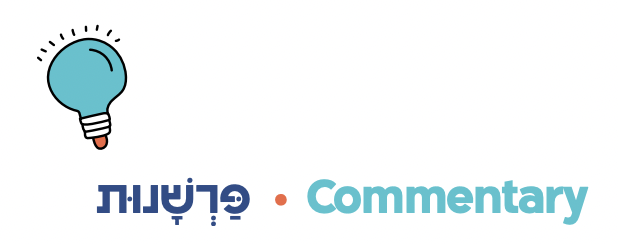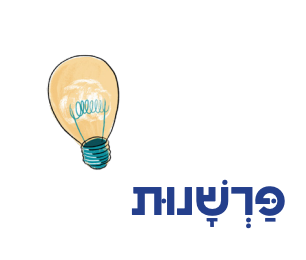Ilustration Credit: Rivka Tsinman

Commentary פַּרְשָׁנוּת
Our parashah tells us about a mitzvah called סְפִירַת הָעֹמֶר (sefirat ha-omer, counting the omer). An omer is a measurement (43.2 eggs in volume, or about 2-5 liters). An omer of barley flour from the new harvest would be collected and offered as a קָרְבַּן מִנְחָה (korban minhah, gift sacrifice), but first it was brought to the כֹּהֵן (kohen, priest) for a special ceremony.
וְהֵנִיף אֶת הָעֹמֶר לִפְנֵי ה' לִרְצֹנְכֶם מִמׇּחֳרַת הַשַּׁבָּת יְנִיפֶנּוּ הַכֹּהֵן׃
He (the kohen) will lift up the omer before God, for acceptance. On the day after the Shabbat the kohen will lift it.
Sefirat ha-omer begins on the day of this special offering.
When was this? It all depends on what מִמׇּחֳרַת הַשַּׁבָּת (mimohorat ha-Shabbat, on the day after the Shabbat) means. The Gemara tells us there was a huge fight over this!
The Rabbis in the Gemara all agreed the pasuk is talking about the second day of Pesah (16 Nissan). They said “the Shabbat” means the Yom Tov that is the first day of Pesah. The day after Yom Tov is the omer ceremony, and that’s when they start sefirat ha-omer.
But there was a group of people called בַּיְיתוֹסִים (bytosim) who interpreted mimohorat ha-Shabbat as meaning, “Sunday,” literally the day after Shabbat. They started sefirat ha-omer on the first Sunday after Pesah started.
The Gemara presents many reasons to support the Rabbis’ interpretation of mimohorat ha-Shabbat. Here’s R. Yosei’s argument.
רַבִּי יוֹסֵי אוֹמֵר ...וְכִי נֶאֱמַר "מִמָּחֳרַת הַשַּׁבָּת שֶׁבְּתוֹךְ הַפֶּסַח"? וַהֲלֹא לֹא נֶאֱמַר אֶלָּא "מִמָּחֳרַת הַשַּׁבָּת." דְּכָל הַשָּׁנָה כֻּלָּהּ מְלֵאָה שַׁבָּתוֹת, צֵא וּבְדֹק אֵיזוֹ שַׁבָּת?!
R. Yosei says: …The pasuk doesn’t say “On the day after the Shabbat that’s part of Pesah.” It just says “On the day after the Shabbat.” The entire year is full of Shabbatot, so how can you know which Shabbat the pasuk is talking about?!
R. Yosei is noticing that the pasuk says ha-Shabbat, which means, “the Shabbat.” It seems to be referring back to a specific day that we’ve been talking about. But there was no discussion just before this of any particular Shabbat! So R. Yosei says ha-Shabbat must be talking about a more specific day: the first day of Yom Tov on Pesah.
Here’s another argument to explain the Rabbis’ interpretation of mimohorat ha-Shabbat.
R. David Zvi Hoffman (Austria, 100 years ago)
The term “Shabbat,” which generally is about a day of rest, can also indicate Yom Tov… you can see that the Torah calls the Yom Tov days of Rosh Hashanah, Sukkot, and Shemini Atzeret a “Shabbaton,” and also calls Yom Kippur “your Shabbat.”
רד"ץ הופמן
הַבִּטּוּי "שַׁבָּת", שֶׁלְּפִי הוֹרָאַת שָׁרְשׁוֹ מְצַיֵּן הוּא יוֹם שַׁבָּת אוֹ יוֹם מְנוּחָה, רָאוּי גַּם לְצִיּוּן יוֹם-טוֹב...
קוֹרְאִים אָנוּ שֶׁלְּיָמִים אֶחָד, חֲמִשָּׁה־עָשָׂר, וְעֶשְׂרִים וּשְׁנַיִם לְחֹדֶשׁ תִּשְׁרֵי נִקְבַּע "שַׁבָּתוֹן," וְעוֹד שֶׁהָעֲשִׂירִי בְּתִשְׁרֵי נִקְרָא בְּפֵרוּשׁ "שַׁבַּתְּכֶם."
- Look it up! Can you find the pesukim in Vayikra chapter 23 where days of Yom Tov are called “Shabbaton” and where Yom Kippur is called “your Shabbat”?
- Check out the beginning of next week’s parashah. Can you find where שְׁמִטָּה (shemittah, the year of release) is called “Shabbat”? How does this support R. Hoffman’s argument?
- If the special term “Shabbat” can be used to refer to Yom Tov and shemittah, what does that tell us about those days? What does that tell us about the importance of Shabbat, or about what Shabbat can teach us about times that are holy?
- R. Yosei and R. Hoffman each defend the Rabbis’ interpretation of mimohorat ha-Shabbat. Can you explain in your own words the difference between each one’s argument? What words or ideas does each commentator focus on?
-------------------





